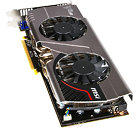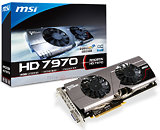Wednesday, April 10th 2013

MSI Rolls Out Radeon HD 7970 Boost Edition Graphics Card
MSI announced a pair of Radeon HD 7970 graphics cards which feature PowerTune with Boost, yet aren't based on the HD 7970 GHz Edition chip. The company labeled these cards simply "HD 7970 Boost Edition." Among the cards MSI unveiled are a base-model (R7970 TF 3GD5 BE), and a factory-overclocked one (R7970 TF 3GD5 BE/OC). The base model features a GPU clock speed of 925 MHz, PowerTune Boost clock speed of 975 MHz, and memory speed of 5.50 GHz. The OC variant, on the other hand, features a GPU clock speed of 1000 MHz, Boost clock of 1050 MHz, and memory clock of the same 5.50 GHz. Hence neither conform to AMD's HD 7970 GHz Edition specs.
Both cards are based on custom designed PCBs and cooling solutions, by MSI. Its trusty Twin Frozr III cooling solution, which uses a pair of 80 mm "Propeller Blade" (high sweep) fans to ventilate a dense heatpipe-fed aluminum fin stack; is in charge of cooling the GPU, while a heatspreader looks after the memory and VRM. TDP of both cards is rated at 253W, both cards draw power from a combination of 8-pin and 6-pin PCIe power connectors. Display outputs on both cards include a dual-link DVI, an HDMI 1.4a, and two mini-DisplayPort 1.2 connectors. MSI did not reveal pricing.
Both cards are based on custom designed PCBs and cooling solutions, by MSI. Its trusty Twin Frozr III cooling solution, which uses a pair of 80 mm "Propeller Blade" (high sweep) fans to ventilate a dense heatpipe-fed aluminum fin stack; is in charge of cooling the GPU, while a heatspreader looks after the memory and VRM. TDP of both cards is rated at 253W, both cards draw power from a combination of 8-pin and 6-pin PCIe power connectors. Display outputs on both cards include a dual-link DVI, an HDMI 1.4a, and two mini-DisplayPort 1.2 connectors. MSI did not reveal pricing.




12 Comments on MSI Rolls Out Radeon HD 7970 Boost Edition Graphics Card
Never mind, I read the article again, it's in reference to it's clock speeds. Sorry, I'm still on my first cup of coffee.
MSI R7970 Lightning Boost Edition preview: The fastest HD 7970 yet
Last year, MSI launched the R7970 Lightning, a graphics card based on the AMD Radeon HD 7970 and aimed at overclockers. It has since been replaced by the R7970 Lightning Boost Edition. Same concept, same price, but with improved performance. Enough for Hardware.Info to check this video card out.
Two things were changed compared to the previous iteration. The R7970 Lightning Boost Edition is built around the AMD Tahiti chip, the same one used in the Radeon HD 7970 GHz Edition. The other difference is that the Boost Edition has newer firmware and different clock speeds.
The standard GPU clock frequency of the Boost Edition is the same as that its predecessor, 1,070MHz. The Turbo mode automatically goes up to 1,150MHz when the load requires it. The memory clock speed has been raised from 1,400MHz to 1,500MHz, which means the new model is slightly faster than last year's.
Aside from these updates, the hardware is identical to last year's version. The graphics card has a special cooler, the MSI Twin Frozr IV; it has five heatpipes (including two thick 8mm ones) and two 10 cm fans. When you turn on the computer the fans blow the other way for 30 seconds in order to remove dust from the heat sink. MSI claims that the shape of the blades generates 20 per cent more airflow. Underneath the cooling block there's another flat, black heatsink that cools the memory and VRM.
MSI completely redesigned the PCB, like it had done with previous Lightning cards, and did it with overclockers in mind. The custom PCB has 17 phases for the power supply; 14 for the GPU, two for the memory and one for the PCI-Express connection. The Radeon HD 7970 reference card only has seven phases, five of which are for the GPU. MSI claims the Lightning card can supply 425 ampère to the GPU, while the reference card is limited to 210 ampère.
The standard Radeon HD 7970 has an 8-pin and a 6-pin power connector, but the Lightning has two 8-pin connectors. The PCB has been designed in such a way that the GPU and the memory use power only from these connectors, and not from the PCI-Express bus that has higher ripple. THe PCB has separate layers for GPU, memory and I/O power supply.
The components are of higher quality as well. MSI used very efficient Hi-C capacitors, CopperMOS mosfets and SSC spools. MSI claims the CopperMOS remains up to 20 percent cooler than traditional mosfets while delivering twice as much power. The SSC spools are validated up to 60 ampère, compared to the standard 40 ampère.
On the back of the R7970 Lightning Boost Edition there's GPU Reactor, which is a small, extra PCB located directly behind the GPU. It has a few extra capacitors that filter the power supply to the GPU additionally, which MSI claims improves stability and can add a few dozen extra MHz during extreme overcooling.
When we tested last year's version of the R7970 Lightning it turned out to be more marketing than anything much performance enhancing. It's easy to remove that extra module, which is necessary if you want to use more than one Lightning card in Crossfire.
The BIOS has been updated as well. By flipping a small switch on the card, you enable the unlocked BIOS. This disables over-current protection (OCP) and active phase switching (APS). This makes all of the power supply phases available at all times. The unlocked BIOS also increases the maximum clock speeds for the GPU and memory to 2500 MHz, and PowerTune can be adjusted from 260 to 460 ampère.
To find out how well this card overclocks and how it compares to other extreme high-end graphics card, read the full review on Hardware.Info.
www.msi.com/product/vga/R7970-Lightning-BE.html
Nvidia engineers must have had a hell of a long vacation after they built that chip.
80mm fans, that is simply brainless idea...